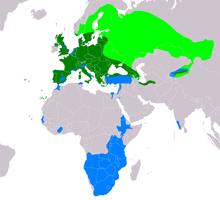
Back Bruinjakkalsvoël Afrikaans Mäusebussard ALS Buteo buteo AN حميمق معروف Arabic حوام شائع ARZ Buteo buteo AST Adi sar Azerbaijani بایاغی شاهین AZB Һар Bashkir Soupis BAT-SMG
| Common buzzard | |
|---|---|

| |
| Steppe buzzard B. b. vulpinus | |
| Scientific classification | |
| Domain: | Eukaryota |
| Kingdom: | Animalia |
| Phylum: | Chordata |
| Class: | Aves |
| Order: | Accipitriformes |
| Family: | Accipitridae |
| Genus: | Buteo |
| Species: | B. buteo
|
| Binomial name | |
| Buteo buteo | |
| Subspecies | |
|
7–10, see text | |

| |
| Range of B. buteo Breeding range of migrant populations Resident range Wintering range of migrant populations
| |
| Synonyms | |
|
Falco buteo Linnaeus, 1758 | |
The common buzzard (Buteo buteo)[2] is a medium-to-large bird of prey which has a large range. It is a member of the genus Buteo[2] in the family Accipitridae.[2] The species lives in most of Europe and extends its breeding range across much of the Palearctic as far as northwestern China (Tian Shan), far western Siberia and northwestern Mongolia.[2][1][3] Over much of its range, it is a year-round resident. However, buzzards from the colder parts of the Northern Hemisphere as well as those that breed in the eastern part of their range typically migrate south for the northern winter, many journeying as far as South Africa.[2][4]
The common buzzard is an opportunistic predator that can take a wide variety of prey, but it feeds mostly on small mammals, especially rodents such as voles. It typically hunts from a perch.[5] Like most accipitrid birds of prey, it builds a nest, typically in trees in this species, and is a devoted parent to a relatively small brood of young.[3] The common buzzard appears to be the most common diurnal raptor in Europe, as estimates of its total global population run well into the millions.[3][6]
- ^ a b BirdLife International (2020). "Buteo buteo". IUCN Red List of Threatened Species. 2020: e.T61695117A181770099. doi:10.2305/IUCN.UK.2020-3.RLTS.T61695117A181770099.en. Retrieved 13 November 2021.
- ^ a b c d e Walls, Sean; Kenward, Robert (23 January 2020). The Common Buzzard. Bloomsbury Publishing. ISBN 978-1-4729-7002-2. Retrieved 22 September 2023.
- ^ a b c Ferguson-Lees, J., & Christie, D. A. (2001). Raptors of the world. Houghton Mifflin Harcourt.
- ^ Bildstein, K. L., & Zalles, J. I. (2005). Old World versus New World long-distance migration in accipiters, buteos, and falcons. Birds of two worlds: the ecology and evolution of migration. Johns Hopkins University Press, Baltimore, Maryland, USA, 154–167.
- ^ Cramp, S., & Brooks, D. J. (1992). Handbook of the birds of Europe, the Middle East and North Africa. The birds of the western Palearctic, vol. 2'’. Oxford University Press, Oxford.
- ^ BirdLife, F. V. B. (2005). Birds in Europe: population estimates, trends and conservation status. British Birds, 98, 269–271.
© MMXXIII Rich X Search. We shall prevail. All rights reserved. Rich X Search
